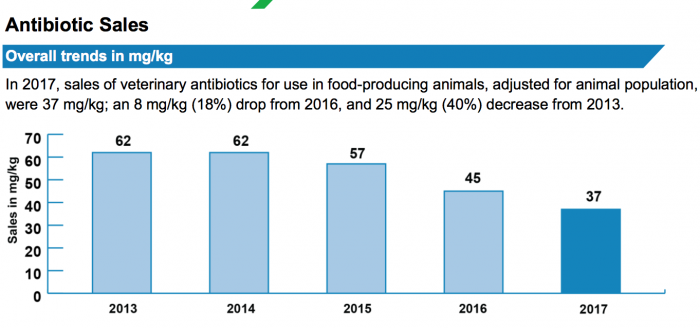Sales of antibiotics for use in food-producing animals dropped by 18% between 2016 and 2017 to reach a new low of 37 mg/kg, official Government figures show.
The latest reduction means sales have also dropped by 40% between 2013 and 2017. The Veterinary Antimicrobial Resistance Sales and Surveillance (VARSS) report also shows that sales of highest priority critically-important antibiotics (HP-CIAs) fell by 29% in 2017.
The report showcases the excellent progress being made in the pig sector, including the 28% reduction in overall use to 131mg/kg in 2017 and HP-CIA usage at just 0.1mg/kg.
Key findings from the VARSS report included:
- For the second year running, the lowest level of sales of veterinary antibiotics in the UK (282 tonnes) was recorded since regular recording began in 1993.
- Total sales of veterinary antibiotics, adjusted for animal populations, was 37 mg/kg in 2017, an additional 18% reduction from 2016 and a 40% reduction since 2013.
- Sales of HP-CIAs dropped a further 29% to 0.8% of total sales in 2017.
- Sales of colistin decreased by a further 94% to 0.001 mg/kg (7.1 kg), considerably below the 1 mg/kg maximum target recommended by the European Medicines Agency (EMA) to protect public health.
- For those sectors where usage data were available for more than one year (pigs, meat poultry, laying hens, gamebirds and dairy), both total and HP-CIA usage decreased compared to 2016.
- The VMD’s surveillance programme shows that resistance to antibiotics in bacterial isolates taken from food-producing animals remains low for most antibiotics, and is absent for others.
- The rates of resistance in healthy pigs at slaughter remained relatively stable between 2015 and 2017 for most antibiotics tested. However, a decline has started to be observed in E. coli coinciding with a reduction in antibiotic use in pigs.
Reaction
Lord Gardiner, Minister for Rural Affairs and Biosecurity, said: “These results show an encouraging reduction of antibiotic use in pigs, poultry and other food-producing animals. I hope that the results will set a further example for our food and farming sectors to tackle the threat of antimicrobial resistance. As we know, good farm management, biosecurity and animal husbandry systems are crucial to achieving this.”
The UK’s Chief Veterinary Officer, Christine Middlemiss, said: “A 40% drop in sales of antibiotics for use in food-producing animals between 2013 and 2017 is an excellent achievement. This is the result of year-on-year improvement in training, stewardship, stockmanship and disease control.
“I praise the industry for their commitment to successfully deliver responsible use of antibiotics and reductions. We must continue to champion infection prevention and disease control to ensure high animal health standards and the optimised use of antimicrobials.”
NPA senior policy advisor Georgina Crayford welcomed the report’s findings, which she said highlighted the progress being made in the pig sector.
“The data serves as evidence of the commitment of pig producers and vets to ensure responsible use of antibiotics in pigs,” she said.
“The ultimate aim of antimicrobial stewardship is to limit further development of antimicrobial resistance and the results of sensitivity testing of bacteria from pigs demonstrate that we are largely succeeding in this.
“The fact that there has been a 99% reduction in veterinary sales of colistin since 2013, to just 0.001mg/kg highlights the power of voluntary industry activity in driving positive change, negating the need for heavy-handed bans.
“The challenge now is for the pig sector to continue delivering against targets set by the RUMA Targets Task Force, and to ensure that the reductions in antibiotic use are sustainable, by ensuring they are supported by better control and prevention of disease.”
RUMA chair Gwyn Jones praised the hard work undertaken to reach this point, with the UK one of the lowest users of antibiotics for farm animals in Europe.
He said most of the reductions over the past few years have come from first the poultry meat sector, then pig and gamebird sectors, which have all released comprehensive usage figures covering almost all their producers.
But he cautioned that there was more to do in driving responsible use while safeguarding animal health and welfare and food safety, including engaging with efforts to improve data collection in some sectors, notably beef, sheep and dairy.




